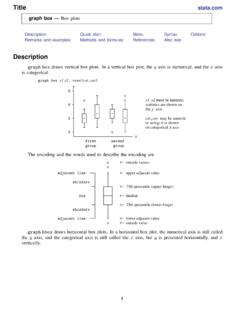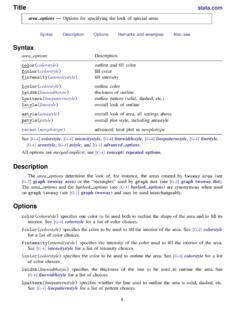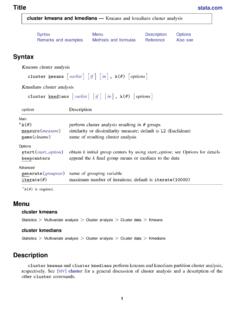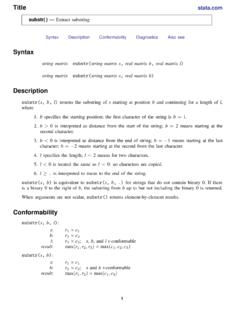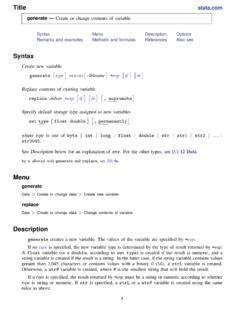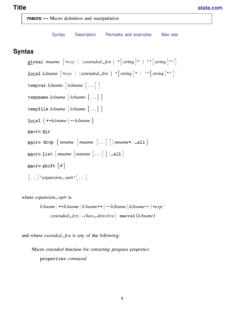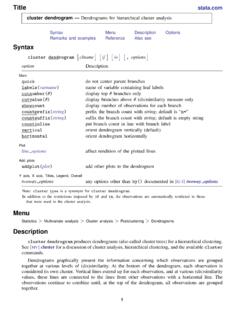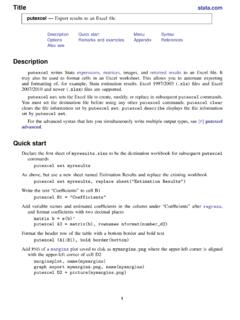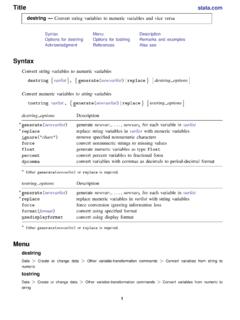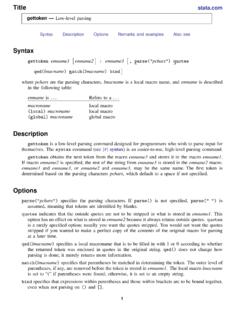Transcription of graph twoway bar — Twoway bar plots - Stata
1 Title graph Twoway bar Twoway bar plots Description Quick start Menu Syntax Options Remarks and examples Reference Also see Description Twoway bar displays numeric (y ,x) data as bars. Twoway bar is useful for drawing bar plots of time-series data or other equally spaced data and is useful as a programming tool. For finely spaced data, also see [G-2] graph Twoway spike. Also see [G-2] graph bar for traditional bar charts and [G-2] graph Twoway histogram for histograms. Quick start Bar graph Twoway bar y x A horizontal bar graph Twoway bar y x, horizontal Bar graph with bars times the default width Twoway bar y x, barwidth(.8). Bars that extend from 0 when the range of y does not include 0. Twoway bar y x, base(20). Add the title My Title to the graph Twoway bar y x, title("My Title"). As above, but add a title X variable to the x axis Twoway bar y x, title("My Title") xtitle("X variable").
2 As above, but with separate graph areas for each value of catvar Twoway bar y x, xtitle("X variable") by(catvar, title("My Title")). Menu Graphics > Twoway graph (scatter, line, etc.). 1. 2 graph Twoway bar Twoway bar plots Syntax . Twoway bar yvar xvar if in , options options Description vertical vertical bar plot ; the default horizontal horizontal bar plot base(#) value to drop to; default is 0. barwidth(#) width of bar in xvar units barlook options change look of bars marker label options add marker labels; change look or position axis choice options associate plot with alternative axis Twoway options titles, legends, axes, added lines and text, by, regions, name, aspect ratio, etc. Options base() and barwidth() are rightmost, and vertical and horizontal are unique; see [G-4] Concept: repeated options. Options vertical and horizontal specify either a vertical or a horizontal bar plot .
3 Vertical is the default. If horizontal is specified, the values recorded in yvar are treated as x values, and the values recorded in xvar are treated as y values. That is, to make horizontal plots , do not switch the order of the two variables specified. In the vertical case, bars are drawn at the specified xvar values and extend up or down from 0. according to the corresponding yvar values. If 0 is not in the range of the y axis, bars extend up or down to the x axis. In the horizontal case, bars are drawn at the specified xvar values and extend left or right from 0 according to the corresponding yvar values. If 0 is not in the range of the x axis, bars extend left or right to the y axis. base(#) specifies the value from which the bar should extend. The default is base(0) when 0 falls between the minimum and maximum of yvar.
4 Otherwise, the default base is the value of yvar closest to 0. barwidth(#) specifies the width of the bar in xvar units. The default is width(1). When a bar is plotted, it is centered at x, so half the width extends below x and half above. barlook options set the look of the bars. The most important of these options is color(colorstyle), which specifies the color and opacity of the bars; see [G-4] colorstyle for a list of color choices. See [G-3] barlook options for information on the other barlook options. marker label options specify labels to appear above the bars. See [G-3] marker label options for a description of marker labels and the options that control them. axis choice options associate the plot with a particular y or x axis on the graph ; see [G-3] axis choice options. graph Twoway bar Twoway bar plots 3. Twoway options are a set of common options supported by all Twoway graphs.
5 These options allow you to title graphs, name graphs, control axes and legends, add lines and text, set aspect ratios, create graphs over by() groups, and change some advanced settings. See [G-3] Twoway options. Remarks and examples Remarks are presented under the following headings: Typical use Advanced use: Overlaying Advanced use: Population pyramid Cautions Typical use We have daily data recording the values for the S&P 500 in 2001: . use (S&P 500).. list date close change in 1/5. date close change 1. 02jan2001 . 2. 03jan2001 3. 04jan2001 4. 05jan2001 5. 08jan2001 We will use the first 57 observations from these data: . Twoway bar change date in 1/57. 100. Closing price change 0 -50 50. 01jan2001 22jan2001 12feb2001 05mar2001 26mar2001. Date 4 graph Twoway bar Twoway bar plots We get a different visual effect if we reduce the width of the bars from 1 day to.
6 6 days: . Twoway bar change date in 1/57, barw(.6). 100. Closing price change 0 -50 50. 01jan2001 22jan2001 12feb2001 05mar2001 26mar2001. Date Advanced use: Overlaying The useful thing about Twoway bar is that it can be combined with other Twoway plottypes (see [G-2] graph Twoway ): . Twoway line close date || bar change date || in 1/52. 1500. 1000. 500. 0. 01jan2001 15jan2001 29jan2001 12feb2001 26feb2001 12mar2001. Date Closing price Closing price change graph Twoway bar Twoway bar plots 5. We can improve this graph by typing . Twoway line close date, yaxis(1). ||. bar change date, yaxis(2). ||. in 1/52, ysca(axis(1) r(1000 1400)) ylab(1200(50)1400, axis(1)). ysca(axis(2) r(-50 300)) ylab(-50 0 50, axis(2)). ytick(-50(25)50, axis(2) grid). legend(off). xtitle("Date"). title("S&P 500"). subtitle("January - March 2001"). note("Source: Yahoo!)
7 Finance and Commodity Systems, Inc."). yline(1150, axis(1) lstyle(foreground)). S&P 500. January - March 2001. 12001250130013501400. Closing price change Closing price 50. 0. -50. 01jan2001 15jan2001 29jan2001 12feb2001 26feb2001 12mar2001. Date Source: Yahoo!Finance and Commodity Systems, Inc. Notice the use of yline(1150, axis(1) lstyle(foreground)). The 1150 put the horizontal line at y = 1150; axis(1) stated that y should be interpreted according to the left y axis; and lstyle(foreground) specified that the line be drawn in the foreground style. 6 graph Twoway bar Twoway bar plots Advanced use: Population pyramid We have the following aggregate data from the 2000 Census recording total population by age and sex. From this, we produce a population pyramid: . use , clear (2000 Census population by age and sex).. list agegrp maletotal femtotal agegrp maletotal femtotal 1.
8 Under 5 9,810,733 9,365,065. 2. 5 to 9 10,523,277 10,026,228. 3. 10 to 14 10,520,197 10,007,875. 4. 15 to 19 10,391,004 9,828,886. 5. 20 to 24 9,687,814 9,276,187. 6. 25 to 29 9,798,760 9,582,576. 7. 30 to 34 10,321,769 10,188,619. 8. 35 to 39 11,318,696 11,387,968. 9. 40 to 44 11,129,102 11,312,761. 10. 45 to 49 9,889,506 10,202,898. 11. 50 to 54 8,607,724 8,977,824. 12. 55 to 59 6,508,729 6,960,508. 13. 60 to 64 5,136,627 5,668,820. 14. 65 to 69 4,400,362 5,133,183. 15. 70 to 74 3,902,912 4,954,529. 16. 75 to 79 3,044,456 4,371,357. 17. 80 to 84 1,834,897 3,110,470.. replace maletotal = -maletotal/1e+6. (17 real changes made).. replace femtotal = femtotal/1e+6. (17 real changes made).. Twoway bar maletotal agegrp, horizontal xvarlab(Males). ||. bar femtotal agegrp, horizontal xvarlab(Females). ||. , ylabel(1(1)17, angle(horizontal) valuelabel labsize(*.))
9 8)). xtitle("Population in millions") ytitle(""). xlabel(-10 "10" " " -5 "5" " " 5 10). legend(label(1 Males) label(2 Females)). title("US Male and Female Population by Age"). subtitle("Year 2000"). note("Source: Census Bureau, Census 2000, Tables 1, 2 and 3", span). graph Twoway bar Twoway bar plots 7. US Male and Female Population by Age Year 2000. 80 to 84. 75 to 79. 70 to 74. 65 to 69. 60 to 64. 55 to 59. 50 to 54. 45 to 49. 40 to 44. 35 to 39. 30 to 34. 25 to 29. 20 to 24. 15 to 19. 10 to 14. 5 to 9. Under 5. 10 5 5 10. Population in millions Males Females Source: Census Bureau, Census 2000, Tables 1, 2 and 3. At its heart, the above graph is simple: we turned the bars sideways and changed the male total to be negative. Our first attempt at the above was simply . use , clear (2000 Census population by age and sex).. replace maletotal = -maletotal (17 real changes made).
10 Twoway bar maletotal agegrp, horizontal ||. bar femtotal agegrp, horizontal 20. 15. Age group 10. 5. 0. -10,000,000 -5,000,000 0 5,000,000 10,000,000. Male total Female total From there, we divided the population totals by 1 million and added options. xlabel(-10 "10" " " -5 "5" " " 5 10) was a clever way to disguise that the bars for males extended in the negative direction. We said to label the values 10, , 5, , , 5, , and 10, but then we substituted text for the negative numbers to make it appear that they were positive. See [G-3] axis label options. Using the span suboption to note() aligned the text on the left side of the graph rather than on the plot region. See [G-3] textbox options. 8 graph Twoway bar Twoway bar plots For another rendition of the pyramid, we tried . use , clear (2000 Census population by age and sex).
